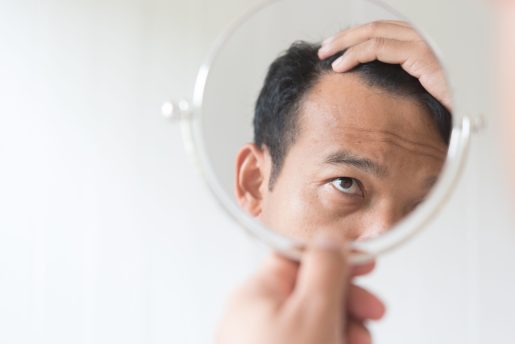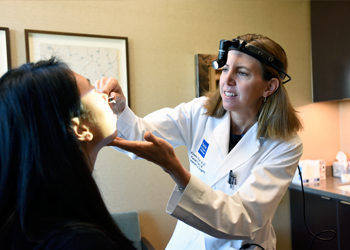Does testosterone replacement therapy cause hair loss?
 In recent years, testosterone replacement therapy (TRT) has grown increasingly popular. However, the rise of specialized clinics and online pharmacies offering easy access to the hormone has outpaced the availability of reliable educational resources. As interest in testosterone replacement therapy grows, concerns have emerged — particularly about its potential side effects, such as hair loss. Baylor Medicine urologist Dr. Blair Stocks and dermatologist Dr. Oyetewa Asempa weigh in on these concerns and offer guidance for patients considering TRT.
In recent years, testosterone replacement therapy (TRT) has grown increasingly popular. However, the rise of specialized clinics and online pharmacies offering easy access to the hormone has outpaced the availability of reliable educational resources. As interest in testosterone replacement therapy grows, concerns have emerged — particularly about its potential side effects, such as hair loss. Baylor Medicine urologist Dr. Blair Stocks and dermatologist Dr. Oyetewa Asempa weigh in on these concerns and offer guidance for patients considering TRT.
TRT is used to increase the overall testosterone levels of a person, and it plays a key role in male characteristics, including hair growth. Testosterone is converted to its active form, dihydrotestosterone (DHT), by the enzyme 5-alpha reductase. Studies have shown that TRT can elevate DHT levels by 2 to 3 times above baseline, depending on the dose and route of administration (e.g., transdermal vs. intramuscular).
“DHT is a more potent androgen than testosterone and binds strongly to androgens receptors in the hair follicle,” says Stocks, assistant professor in the Scott Department of Urology at Baylor.
Over time, elevated DHT levels can cause hair follicles to shrink. The process, known as miniaturization, results in thinner hair. Eventually those follicles stop producing visible hair altogether.
The medical term for male pattern baldness is androgenetic alopecia (AGA). This is the most common type of hair loss in men. In most cases, this is a genetic condition that happens with age. In this condition, a person’s growth phase in their hair follicles is genetically programmed to start shortening over time, leading to finer, shorter and lighter hair.
Risk factors include:
- Family history (on either side).
- Age (can begin as early as puberty and worsen over time).
- Elevated androgen levels from medications like TRT.
There is no one-size-fits-all solution to reduce hair loss for patients undergoing TRT; instead, it could take a combination of therapies.
“This can be difficult, but we combine multiple therapies to slow down hair loss from TRT,” says Asempa, assistant professor of dermatology and director of the Skin of Color Clinic at Baylor. “We can stimulate hair growth with topical or oral minoxidil (5% foam or liquid is available over the counter, but we can prescribe high percentages). Other therapies to stimulate hair include platelet-rich plasma injections, microneedling, red-light therapies and mesotherapy (injections of minoxidil or other medications directly into the scalp).”
Medications such as finasteride or dutasteride that will block the enzyme 5-alpha reductase also are hair loss treatment options, Asempa says.
“At the right doses, these medications can generally lower activated testosterone in the hair follicle without altering the other benefits of TRT, but this must be done alongside that patient’s endocrine or urology team,” she said. “Additionally, we can review the TRT formulation or dose, as some men can have symptom control with lower dosages.”
Stocks emphasizes that patients considering TRT who are worried about hair loss should have a thorough conversation with their physician beforehand. Key points to cover include:
- Baseline hormone levels: Measuring your DHT and testosterone levels before starting treatment can help set realistic expectations.
- Formulation matters: Transdermal TRT (like gels or patches) may cause higher spikes in DHT compared to intramuscular injections, which could impact hair health.
- Preventive options: Discussing hair-preserving treatments such as finasteride before beginning TRT can help protect your hair follicles from potential damage.
If a patient plans to undergo TRT, and hair loss is a concern, it is important to bring up those concerns with the prescribing physician, in addition to a dermatologist.
“We work together to determine the right medication regimen for these patients,” Asempa says. “I never prescribe finasteride or dutasteride to a patient on TRT without first consulting the urology team. We can also work together by referring patients to each other and keeping in communication.”
By Alexandria Brown, senior marketing associate in the Scott Department of Urology



